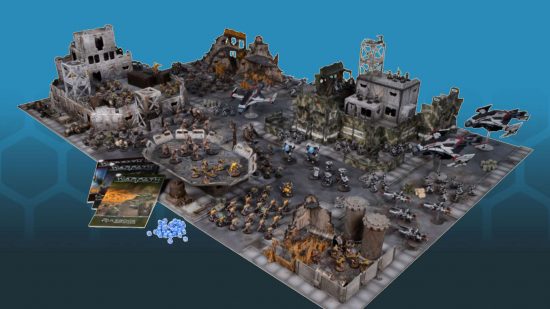Speaking to Wargamer, Mantic Games’ CEO and founder Ronnie Renton explains how his love of massive wargame battles with hundreds of models on each side was a key force in the creation of both Warhammer 40k Apocalypse and Mantic’s upcoming small-scale wargame Epic Warpath.
Renton founded Mantic in 2008, leaving a career in Games Workshop. His final role at GW was product and marketing director, running Games Workshop’s Warhammer design studio and the global marketing team. Among the projects he championed was Warhammer 40k Apocalypse, a spin-off that enabled players to field huge armies and jumbo-sized miniatures in true mega-battles.
Not everyone at Workshop took to the idea: “People asked “How can you have a tank that’s as big as the range on a lasgun?””, Renton recalls. But that’s just the kind of game he likes. “My idea of fun is getting out all the toys that you can find on the biggest gaming table you can possibly imagine”, he enthuses.
That passion has led, eventually, to Mantic’s latest game, Epic Warpath, which is currently raising funds on Kickstarter. With miniatures in 12mm scale, it’s a game of clashes between massive forces of teeny-tiny infantry and armor, with a rules engine similar to classic Epic 40k. It’s actually the third edition of Warpath, and the first in the diminutive Epic scale – and Renton’s fixation on giant battles is part of the reason why the game has been put under the shrink ray.

Mantic’s first sci-fi wargame was Deadzone, a 28mm game built from the ground up to facilitate skirmish combat. “The terrain, the models, everything just works together because it was all designed together”, Renton explains. The game has very clean rules for movement and measuring ranges based around the game’s terrain, which follows a 3D cubic grid – no tape measure needed.
Mantic anticipated that players building collections of Deadzone miniatures might want to use them all at once in bigger battles. “The plan was, you end up with 20 figures and you think ‘I’m halfway to a full wargame’”. To meet that desire, the firm envisioned a platoon level game called Firefight. Then, “once you’ve built ten Firefight units, you start going ‘Well now I can play a real wargame with a hundred miniatures and fifty tanks!’” – which was where Warpath would come in.

When Mantic first conceived of the two games and took them to Kickstarter in 2015, the firm proposed a largely shared ruleset with a few adjustments between them to account for the different sizes of the forces on the field. But as things shook out “we didn’t write them that way, they had their own DNA and it wasn’t quite as slick”.
Warpath made it to a second edition, but as designer Matt Gilbert writes in a blog post in August 2023, “it competed with Firefight at the same scale”. Sometimes, the sense of scale is more about what’s fighting than how many miniatures are on the table. The recent Command Protocols edition of Firefight makes battles with a half and half mix of infantry and vehicles feasible: “You can fight Kursk, which is great fun”, Renton says.
But as for Warpath, “what was kind of clear is that I am slightly insane”, Renton says. “Not everybody wants to play all day with thousands of tanks at 30 mm scale”. However, “they might be happy to do it if it’s only at 10mm”.
Judging by the Warpath Kickstarter, which funded in under half an hour and has over $225,000 in pledges, people are all too happy to give that a shot. Renton is satisfied: “I get my big battles, [Matt Gilbert and Alessio Cavatore] get to write a ruleset for Warpath that people might actually enjoy”.
Wargamer is as eager as Renton is for Epic Warpath – we’re suckers for titchy-scale miniatures, as you can see in our Legions Imperialis review. You should also check out our Deadzone third edition review to see what we think of the most recent version of Mantic’s first sci-fi wargame.
There’s more to come from our interview with Renton. Naturally, we had to ask him about Kings of War, one of the best fantasy wargames on the market – so stay tuned for that!
Source: Wargamer




